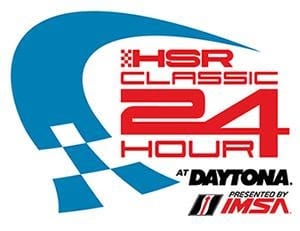DAYTONA BEACH, Fla. – In advance of this year’s fifth running of the Historic Sportscar Racing Classic Daytona presented by IMSA, HSR officials announced today a change and expansion of the Run Group structure for the Classic 24 Hour race.
The event returns to Daytona Int’l Speedway, Nov. 13-17.
The major move is the division of Group E into two distinct classes each featuring modern but retired prototypes and GT race cars from this century.
Run Group E remains a showcase of such iconic machines as the Audi R8, Pescarolo Judd, Peugeot 908 and Lola B07 LMP race cars that now compete in the group with Daytona Prototype International (DPi), LMP2 race cars and others just past their prime.
The Group E split paves the way for Oreca FLM09 Le Mans Prototype Challenge (LMPC) “PC” cars and Gen 2 and Gen 3 Daytona Prototypes to compete for overall honors in a move to a completely restructured Run Group F.
Still current in their appeal but no longer eligible in contemporary racing series, the “DP” and “PC” cars will compete in Group F against retired LMP2 cars of the same era.
“Daytona Prototypes and LMPC cars have become quite popular with HSR competitors in recent years,” HSR President David Hinton said. “Both have been competitive but are a little outmatched against the LMP machines that have set the standard in Group E since the inaugural HSR Classic Daytona in 2014. Moving ‘DP’ and ‘PC’ to Group F, where they will be able to contend for the overall victory, has been a popular decision with our competitors and brings back a familiar scene for race fans that watched both classes compete at Daytona in their prime just a few years ago.”
Eligible GT cars in Group E include the Ferrari 458, Porsche 991, Viper GTS-R and GT3 and similar top-end GT sports cars. Production-based GT cars in Group F will see slightly older and less powerful FIA, IMSA and GRAND-AM GT1, GT2, GS, GT3, GT4 and World Challenge and “Cup” and “Challenge” race cars all eligible to get in on the action.
Group F was formerly home to competitors in HSR classes with race cars not represented in the other six other groups.
Rechristened Run Group G, the category offers a variety of primarily production-based cars that includes many of the same teams and race cars that compete in HSR’s Vintage GT and Historic GT groups and HSR Classic RS Cup and HSR Global GT series.
Run Groups A through D continue with no major technical or race car eligibility changes from previous years, but a competition format change will see Groups C and D compete simultaneously for the first time in the 2019 HSR Classic Daytona.
Competitors will share the track but separate Group C and D victory lane podiums and awards for both groups will be presented at the conclusion of the HSR Classic Daytona on Sunday.
Doubling up Groups C and D ensures the traditional format of the HSR Classic Daytona will literally continue like clockwork again this year. Including the combined Group C and D sessions, each HSR Classic Daytona Run Group takes to the track four times throughout the 24 hours.
The competitors in each group covering the most total distance in the shortest amount of time in their four sessions will be crowned Classic Daytona presented by IMSA champions.
